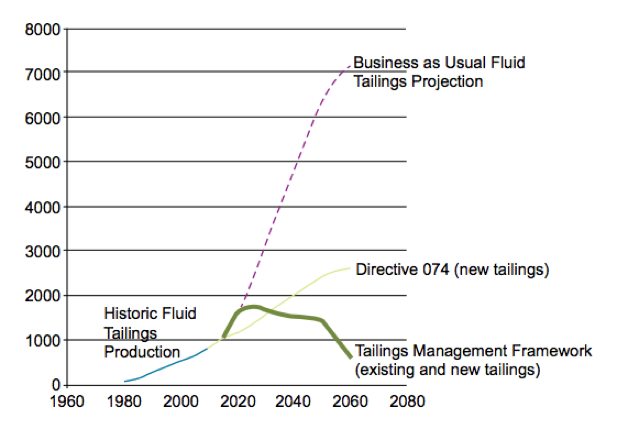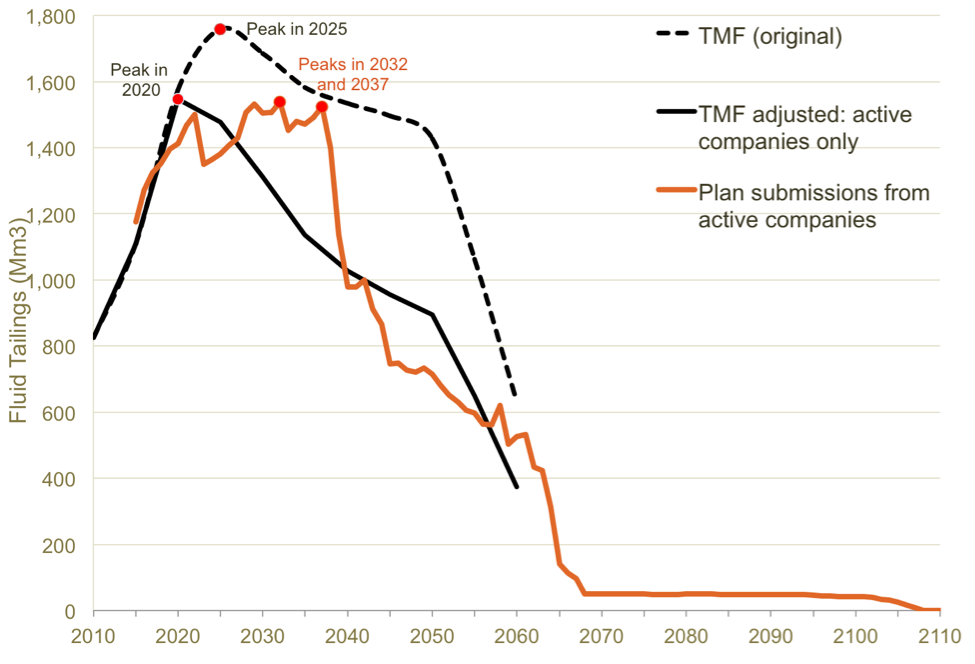This year is poised to be a decisive one for the future of tailings ponds in the Alberta oilsands. In 2017, the Alberta Energy Regulator (AER) will assess and grant regulatory conditions that oilsands mining companies must follow to manage and clean up the toxic mining waste currently sitting in ponds that span over 220 square kilometres of the Northern Alberta landscape. In November 2016, all existing oilsands mining operators submitted their proposed Tailings Management Plans (TMPs) as required by Directive 085: Fluid Tailings Management for Oil Sands Mining Projects.
The AER designed Directive 085 to implement the management direction of the Government of Alberta’s Tailings Management Framework for the Mineable Athabasca Oil Sands (TMF), released in March 2015. If it is to compel companies to clean up approximately 1 trillion litres of fluid tailings, there must be unified and relentless commitment to upholding the intent and objectives of the TMF. There are concerns that could hinder that success.
Water-capped tailings
Nearly every company submission proposes “water capping” to treat tailings. This would involve placing fluid tailings at the bottom of open pits and capping it with fresh water to form permanent man-made lakes. Its proponents contend that the tailings will settle naturally and consolidate at the bottom, as the lakes are integrated into the surrounding environment. Syncrude’s Base Mine Lake was commissioned in 2013 as the first commercial-scale demonstration of water-capped fluid tailings. A new Demonstration Pit Lakes facility is currently under development to build upon this ongoing research.
However, doubt persists regarding whether this technology will work as intended in the long-term. Further, there is a major policy gap concerning the use of open water management systems in final reclaimed landscapes in Alberta. Directive 085 requires viable contingency plans for proposed end-pit lakes with water-capped tailings. Not all TMPs submitted in November have contingency plans. The AER must enforce the Directive and not approve industry strategies that don’t have comprehensive contingency plans with realistic alternatives to water capping.
Cumulative tailings volumes
The TMF includes a graph that illustrates how it is expected to impact estimated potential industry-wide fluid tailings volumes (Figure A). This graph is a central reference point to ensure the success of the policy framework. To protect the environment, a maximum allowable volume of tailings must be enforced.
Figure A

The results of this analysis are concerning. Using government data, the TMF curve was adjusted to remove all projects for which no tailings management plans have been submitted. This adjusted curve demonstrates that, after 50 years of unchecked growth, it could be 20 more years before industry stops adding tailings to the landscape (Figure B). With total untreated fluid tailings volumes having reached 1.18 trillion litres in 2015, this is simply not an acceptable outcome. Moreover, it means that submissions in aggregate are not consistent with the TMF.
Figure B

Compliance and enforcement
Since Directive 085 was designed to be flexible in permitting companies to design their own tailings treatment criteria, the AER needs to delineate a rigid regime for compliance and enforcement and clear, stringent penalties for exceeding these thresholds. This will be imperative to regain the trust of the public following the lack of enforcement of the previous directive: 074. It will also allow public and stakeholders to provide longer-term oversight to ensure Directive 085 is enforced.
Determination of RTR criteria
In the TMF, the term “ready to reclaim” describes fluid tailings that “have been processed through an accepted technology, have been placed in their final landscape position, and have achieved necessary performance criteria.” These performance criteria are to be developed on a case-by-case basis by the AER as it reviews each application.
What the AER accepts in terms of what criteria constitute sufficient “treatment,” will ultimately determine the Directive’s effectiveness. Therefore, stakeholders and the public needs to understand how the AER has selected reclamation criteria for each project, and how to judge the AER’s conditions.
Moving forward
With more oilsands mines preparing to close their operations in the early-2030s, it is crucial that after 50 years of mismanagement the problem of fluid tailings is properly dealt with now. Pembina supports the TMF and Directive 085, and is strongly committed to ensuring the intent and objectives of the policy framework are fully realized by the sum of industry’s TMPs.
However, honouring the intent of the TMF depends on sustained commitment from all parties involved to ensure no corners are cut in its implementation. Albertans have been promised that fluid tailings will be removed from the landscape and deserve to know that Alberta’s regulators will protect the public interest in ensuring that the rules will be followed.
This is the third blog in a Pembina Institute series on the oilsands tailings issue. Read the first here: "Oilsands tailings back in the spotlight" and the second here: “Three strikes and you’re out?”
For more information on tailings management in Alberta, please check out Pembina Institute's recent whitepaper on Directive 85, and Statements of Concern on industry's individual management plans.










